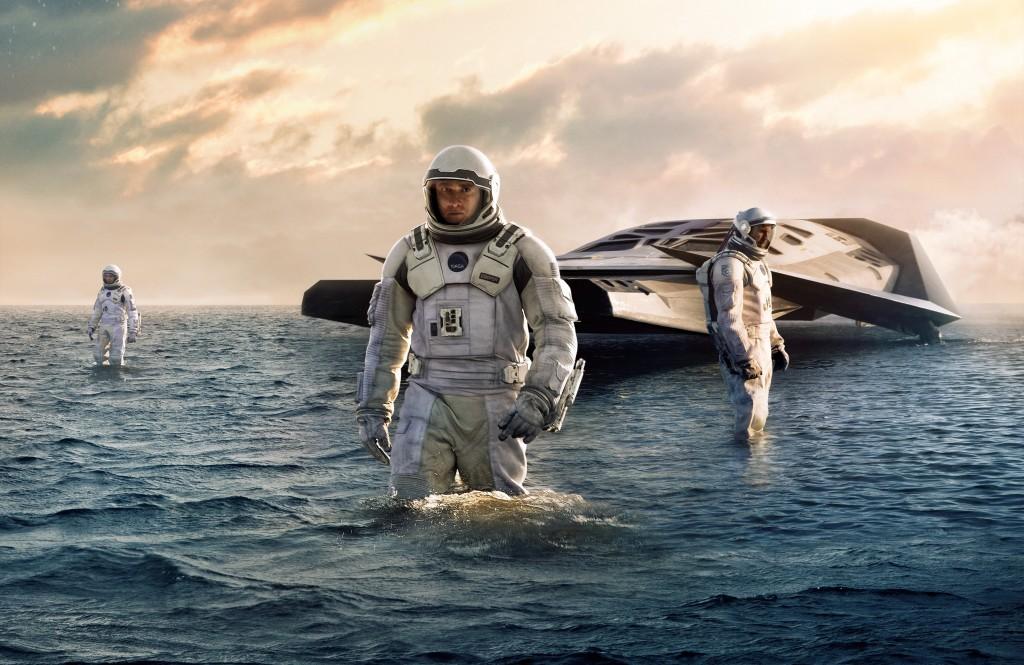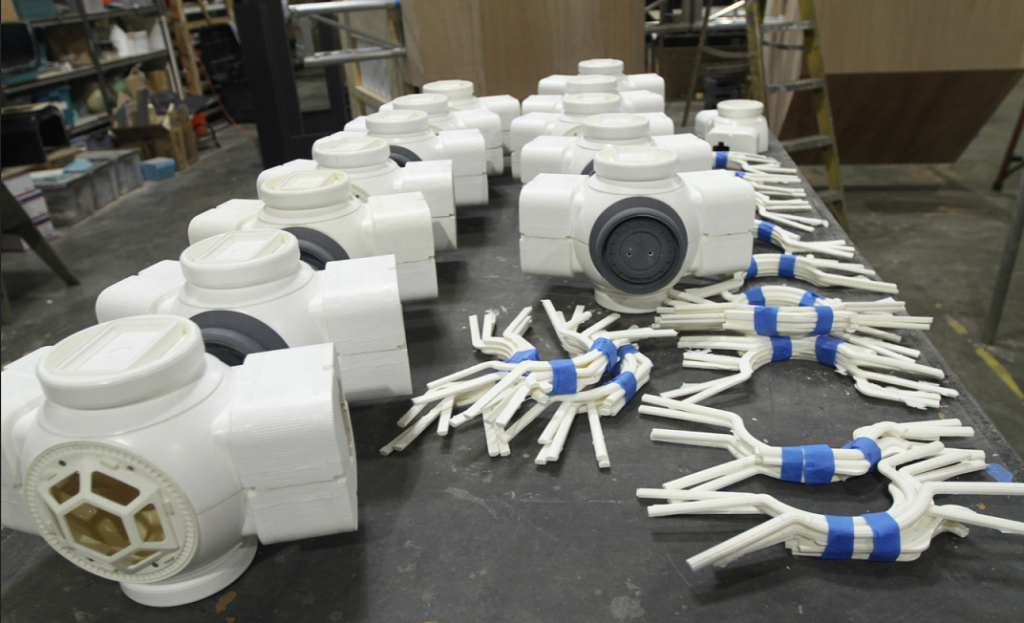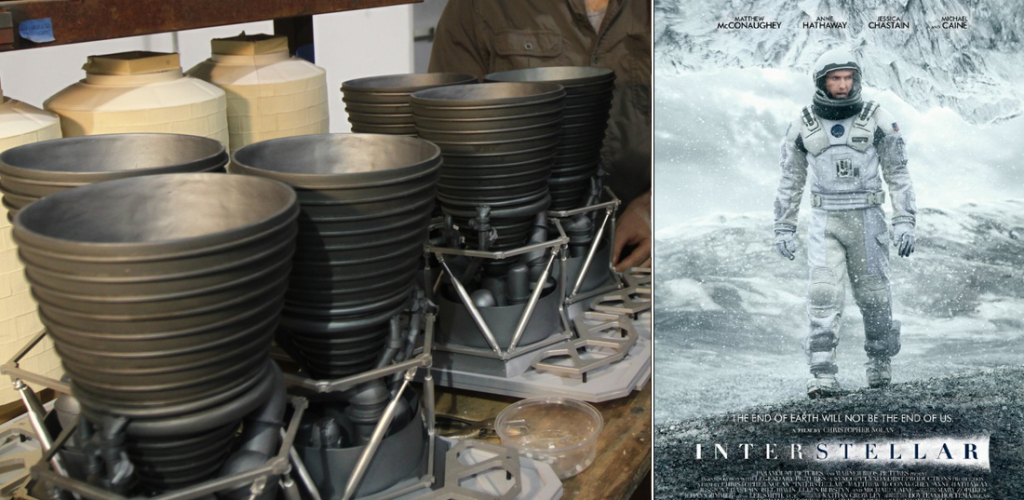Exclusive: Interstellar’s Reliance on 3D Printing May Have Won New Deal Studios an Oscar for Best Visual Effects
 The technology of 3D printing has made a stunning impact on the world of art and design, and its benefits have certainly not been lost on those involved in the movie making industry. These are not people willing to remain stuck inside any box, and over the past few years we’ve seen special effects crews rapidly evolving, first just beginning to dabble and then quickly progress in 3D printing with dazzling visual effects in children’s movies like Coraline and the BoxTrolls.
The technology of 3D printing has made a stunning impact on the world of art and design, and its benefits have certainly not been lost on those involved in the movie making industry. These are not people willing to remain stuck inside any box, and over the past few years we’ve seen special effects crews rapidly evolving, first just beginning to dabble and then quickly progress in 3D printing with dazzling visual effects in children’s movies like Coraline and the BoxTrolls.
The technology is in fact becoming so integrated in movie making that rather than dabbling or experimenting, 3D printing and setting up a lab for doing so is now becoming first on the list for many talented, progressive teams of designers as they begin a new project.
While Interstellar’s Cooper (played by Matthew McConaughey) and the crew had quite the intense mission heading into space to try to find a way to move Earthlings to a more healthy and sustaining celestial body, the special effects crew for the movie had a very real and  challenging mission of their own. They were tasked with transporting us to another time, transforming our world as one that was quickly headed for an apocalypse. They rocketed astronauts into space, encapsulated in realistic looking spacecraft, as well as putting them out and about on other planets.
challenging mission of their own. They were tasked with transporting us to another time, transforming our world as one that was quickly headed for an apocalypse. They rocketed astronauts into space, encapsulated in realistic looking spacecraft, as well as putting them out and about on other planets.
And what a job the entire movie crew of Interstellar performed as a whole, taking us into the world of space—and crisis—with Cooper, and also winning an Oscar for visual effects in the process. Now that’s validation for progressive talent and the technology being used.
Director Christopher Nolan turned to Los Angeles-based New Deal Studios for visual effects. Famed for movies like The Dark Knight, Inception, Hugo, Guardians of the Galaxy, and Avengers, New Deal is a full featured production house that works in the movie pipeline as a comprehensive source.
With over 20 years in the movie business, while they have evolved over the decades into a complete content house featuring writers, directors, and producers, New Deal’s specialty is obvious: visual effects. This is a team that was able to bring their incredible pool of talent to match the challenges Nolan would throw at them. Resolutely, they were able to use creativity most of us could never even begin to touch on, coupled with 3D printing technology which was able to lend the realism and support they required.
“For Interstellar, Christopher Nolan wanted the ships to feel like real spacecraft that people could relate to, so much of the design of the ships comes from NASA reference,” said Jeffrey Jasper, Digital FX Supervisor & CTO of New Deal Studios, Inc.
This meant using complex digital design, and as Jasper explained, they used the following process:
- They prepped all the parts of the spacecraft with MODO, a specialized software from The Foundry.
- The team used CG models from Double Negative in London for digital FX and previsualization, as well as full and scaled sets.
- All files were exported to Rhino and converted to NURBS models for generating build drawings.
New Deal’s reliance on 3D printing had been growing over the years, and this time, rather than sending work out to another source for 3D printing, New Deal began by purchasing a 3D printer specifically for the Interstellar project. This would be a pivotal decision, and perhaps part of the beginning of what took Interstellar to an Oscar-winning evening. The team began with an Airwolf 3D XL, and then pressed on, expanding further with both an Afinia 3D printer, as well as a Form1.
“From a 3D printing perspective this project was unique for us,” Jasper told 3DPrint.com. “In the past we used a local service company to do high quality prints for us. We knew we were going to be doing a ton of 3D printing and sending the parts out would be too cost prohibitive.”
While their experience and results with 3D printing in-house were obviously more than stellar, it wasn’t without a learning curve and a few stumbles in the road, as they experienced after running their new Airwolf 3D XL at “full tilt day and night.” With that amount of production, the Airwolf began to have jamming issues.
Jasper and his team chose the Airwolf because they knew that the company was in close enough proximity to offer great support for their foray into their own 3D printing lab for Interstellar. This proved to be a good idea as Airwolf was able to outfit the 3D printers running overtime with a new, jam-free system.
“We did all of our large pieces and large groups of pieces on the Airwolf,” said Jasper. “The new print head was awesome and it fitted to all their printers now. We never had another jam for the rest of the build.”
Shortly after that, they purchased the Afinia 3D printer, which presented another very positive experience. Although the machine featured a much smaller build area, it was another workhorse for the visual design team. The Afinia was responsible for producing most of their smaller, mechanical 3D printed parts, and Jasper noted that out of all the 3D printers they used, its well-designed, reliable setup offered them the best experience of all, with an extremely low failure rate.
The third 3D printer purchased by the New Deal team was the Form1 3D printer from Formlabs.
“The Form1 got us quality that was equal to, if not better than, the service company prints we were getting before,” Jasper told 3DPrint.com. “Being an SLA printer, even when set to 100 micron layers, you get a really nice surface finish that FFF printers just can’t match.”
“The Form1 was also the fastest printer by far,” said Jasper. “Part cleanup is messier, but it’s nothing professional printers are not used to. We used the Form1 for detail parts.”
Since then, New Deal has upgraded to a Form1+ and they are pretty pleased with themselves to be getting such incredible results from a desktop printer that they are considered to rival industrial printers in terms of what they are able to produce.
“New Deal has long been a proponent of RP parts. Our first printer from more than a decade ago was a large wax printer and as times have changed we have changed with the technology. I am really excited by the SLA and SLS printers coming to market this year and desktop CNC machines as well. I am keeping my eye on the metal printing market too,” said Jasper.
“3D printing is key to our industry. To hit the deadlines and price points our clients demand we have to look at all efficiencies we can get and RP parts are a huge time savings and with the desktop printer revolution it is also a huge cost savings.”
 Just as 3D printing is saving time and money, and helping to produce better quality in other sectors from automotive to aerospace and many different facets of the medical industry, it’s changing the world of the special effects artist. Even the hardest-working people in the world need to take time out for recreation, and nothing is more relaxing than a great movie with awesome effects.
Just as 3D printing is saving time and money, and helping to produce better quality in other sectors from automotive to aerospace and many different facets of the medical industry, it’s changing the world of the special effects artist. Even the hardest-working people in the world need to take time out for recreation, and nothing is more relaxing than a great movie with awesome effects.
“It still takes an amazing team of talented artists to turn those parts into film worthy FX but it helps get us there faster and cheaper than having to fabricate everything by hand,” Jasper noted.
For most of us, trying to comprehend how a crew takes a movie concept from A to Z, transporting us to another world, is completely mind-boggling. Our job as the audience is to enjoy the ride, while experts like New Deal Studios use their technical expertise and progressive innovations allowed with technology and innovation via 3D printing.
What a fascinating journey in every way—and one that took the Interstellar team to the 87th Academy Awards, where they were the recipients of the Best Visual Effects award, as well as receiving nominations for numerous other categories. They also won the BAFTA award for the Best Special Visual Effects.
Along with the other many other moviegoers who saw this inspirational, provocative film that left us white-knuckled, gripping our seats at times as we felt like we too held the fate of mankind in our hands—we too applaud.
Did you see Interstellar? Were you aware that the special effects crew had employed the technology of 3D printing so heavily? Tell us your thoughts in the 3D Printing for Interstellar forum over at 3DPB.com.
Subscribe to Our Email Newsletter
Stay up-to-date on all the latest news from the 3D printing industry and receive information and offers from third party vendors.
You May Also Like
Profiling a Construction 3D Printing Pioneer: US Army Corps of Engineers’ Megan Kreiger
The world of construction 3D printing is still so new that the true experts can probably be counted on two hands. Among them is Megan Kreiger, Portfolio Manager of Additive...
US Army Corps of Engineers Taps Lincoln Electric & Eaton for Largest 3D Printed US Civil Works Part
The Soo Locks sit on the US-Canadian border, enabling maritime travel between Lake Superior and Lake Huron, from which ships can reach the rest of the Great Lakes. Crafts carrying...
Construction 3D Printing CEO Reflects on Being Female in Construction
Natalie Wadley, CEO of ChangeMaker3D, could hear the words of her daughter sitting next to her resounding in her head. “Mum, MUM, you’ve won!” Wadley had just won the prestigious...
1Print to Commercialize 3D Printed Coastal Resilience Solutions
1Print, a company that specializes in deploying additive construction (AC) for infrastructure projects, has entered an agreement with the University of Miami (UM) to accelerate commercialization of the SEAHIVE shoreline...































